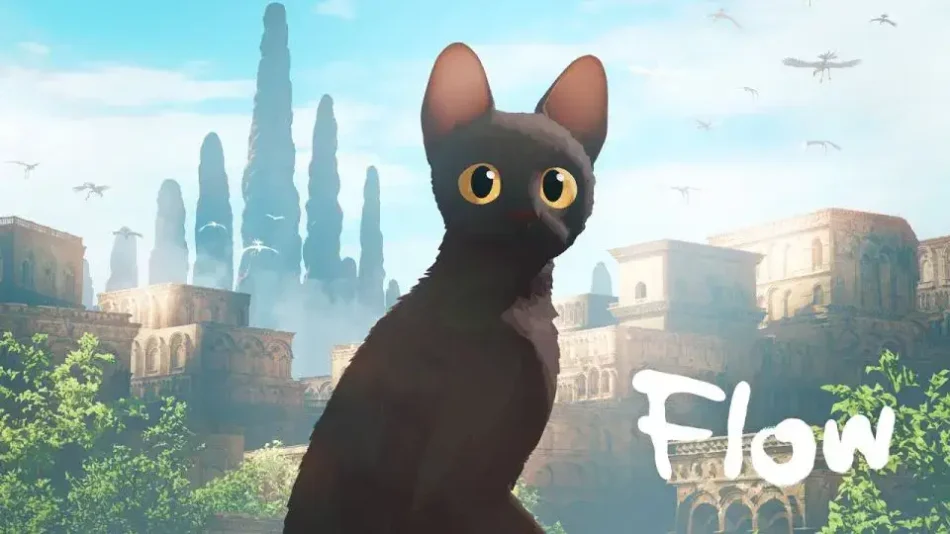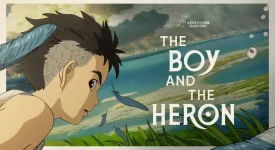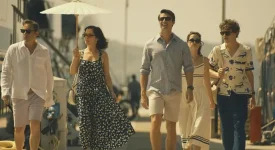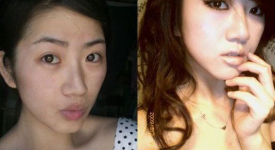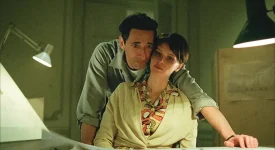(may contain spoilers)
Flow
Douban rating: 8.4
Director: Gints Zilbalodis
Douban Comments: “On a boat, there are five animals, each representing one level of Maslow’s hierarchy of needs.
The capybara represents basic physical needs – eating, drinking, sleeping, and going to the bathroom. It’s the first companion of the kitten.
The lemur stands for safety needs – protecting belongings and avoiding danger. But the lemur guards a pile of useless jars, showing how we sometimes cling to meaningless things. It is the second companion.
The third is a golden retriever, representing social needs. Whether it’s bad company or good friendships (like with the kitten), it reflects the need for love and belonging.
Next is the secretary bird, symbolizing esteem needs – the desire for respect and dignity. This reflects the highest, most noble, and almost divine part of human reason.
Finally, the kitten itself represents the need for self-actualization. Through the flood and drifting journey, it experiences all five levels of needs. In the end, by saving the pufferfish, the kitten achieves personal growth.
Throughout the film, the kitten falls into water several times, and in the final scene, it stares at its reflection. The flood represents the subconscious mind. The whale stands for both the free, imagined self and the fearful, stranded self. All these layers of self are hidden in the deep subconscious, waiting for the tides of life to rise and fall again.”
“I absolutely loved this film; it was my favorite at this year’s Shanghai International Film Festival.
The camera always stays low, capturing the expressions of the animals in great detail, which makes it easy to feel immersed in their world. There’s not a single line of dialogue throughout the film, yet the communication between the animals is clear, vivid, and deeply moving. Their personalities are full and rich – both cute and brave, with moments of danger that feel real.
At the end of the film, when the floodwaters recede and the boat ends up in a tree, it seems to return to the scene from the beginning, like a cycle. The white bird belongs to the sky, the whale to the deep sea, and the brave animals to the vast land. To me, this shows that no matter how the world changes – whether it’s the age of the sea or the age of land – every individual has their own journey to face and conquer.
Interestingly, there are no human characters in the film – only a hand-shaped statue appears – suggesting that humans once existed. Through reflections in the water and mirrored surfaces, the animals begin to recognize themselves and develop self-awareness. In this way, the film also seems to ask: in a world beyond human-centered thinking, who truly owns nature?
Anyway, the little cat and the dog are just the best!”
“At the beginning of the film, the wooden boat hanging in the tree hints at the repeated rise and fall of the floodwaters. This Noah’s Ark drifts through the flood, creating the warmest ripples in the submerged world. When the secretary bird flaps its wings and causes a misunderstanding, and the dog awkwardly protects the cat, it finally understands the kindness. Later, the scene of them sharing small fish on the boat’s edge speaks louder than any words of reconciliation.
The lemur is obsessed with collecting glassware, but when it receives a mirror from the capybara, it sees something more precious than its collection – the starlight in its companion’s eyes. The director transforms the disaster into a fairy tale canvas: the whale’s back becomes a lifeboat, the secretary bird ascends to the heavens amidst rainbow-colored clouds, and even the dramatic scene of animals pulling the boat with ropes at the cliff’s edge becomes a cute, collective expression.
In the film’s post-credits scene, the stranded whale sways its tail and returns to the sea, leaving the audience with a smile – this world will always leave a back door for gentle souls. The cat teaches the capybara how to row, the aloof secretary bird kicks the ball into the water, and the cat finally learns to swim – these furry warriors show us with their most authentic selves that what will survive the apocalyptic flood is the warmth of mutual support.”
Into the Mortal World
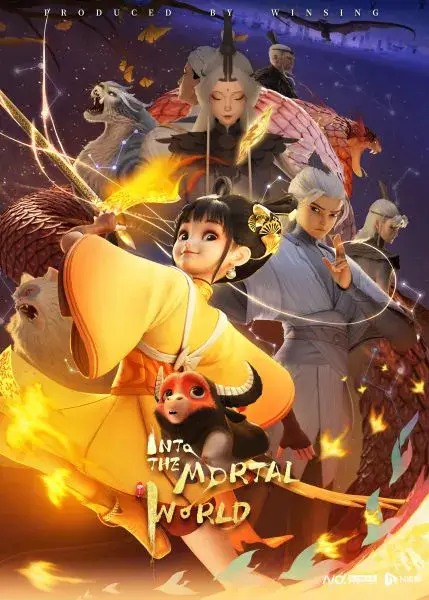
Douban rating: 7.8
Director: Ding Zhong
Douban Comments: “At first, I thought it wouldn’t be anything special, but it completely exceeded my expectations. The world-building, smooth storytelling, and especially the emotional ending were just as impressive as works from studios like Light Chaser or Coloroom – really touching.
Using the 28 lunar mansions and silk embroidery as a foundation, the story explores themes like fate and family emotions from an Eastern cultural perspective, all while keeping it fun and engaging like a game. It shows that Chinese people have their own ‘zodiac signs’ and their own version of ‘where the magical stars are’.
There’s a detail in the second half that really hits home – after the Weaver Girl’s golden shuttle is restored in the underworld, its power brings Jin Feng and Xiao Fan back to life. On the surface, it seems like a story about blood ties, but at its core, it’s about belief. It’s Jin Feng’s faith in the golden thread that makes it happen. They chose to become family – not by blood, but by heart.”
”At first, I couldn’t get used to the art style – it felt kind of wrong to me – but gradually, I came to accept its unique, ‘aesthetic of the unattractive’ look. As a Chinese animated film, the script still has its flaws. Some details and logic don’t really hold up under close scrutiny, but thankfully, none of them are deal-breakers. The overall genre formula works, and even though the themes are the usual ones we often see in Chinese animation, they’re still effective.
The second male lead, a celestial being, mirrors Ao Bing from Ne Zha, but his character falls apart in the third act, missing a chance to add more depth to the main character. The Earth God and the little bunny also get introduced and then just vanish.
Once the main character and his sister get their mother’s golden shuttle, their power levels suddenly go through the roof – it’s a classic ‘power boost by plot’, and you just have to roll with it.
The part where the protagonist comes to the human world to capture the star spirits could’ve been an entire Hollywood-style movie by itself. Then the whole conspiracy, uncovering the truth about his mother, and saving the world – that could’ve been a separate story. If they want to really follow the Hollywood model, it would help to focus more on internal character growth. Whether it’s defeating villains or saving the world, in the end, it should be about solving one’s inner struggles. Chinese animation often gets this backwards, focusing too much on the ‘chosen one saves the world’ trope.“
The Wild Robot
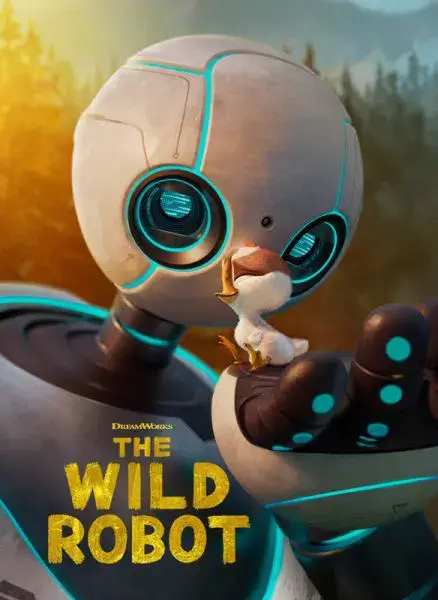
Douban rating: 8.1
Director: Chris Sanders
Douban Comments: ”I’d suggest renaming it Love, Wilderness, and Robots. The film is packed with laughs, almost from beginning to end, all wrapped in warmth and gentle humor. This is exactly what a joyful movie experience should feel like.
Even though ‘love’ isn’t in the title, it’s present everywhere in the story. I believe everyone will feel it – the kind of love you truly believe in, deep in your heart.
The part that touched me most – the one that brought the most tears – was right before they let each other go for the first time. That longing, that reluctant farewell, carried a kind of love that has always guided and grounded me. True love isn’t about control or conditions. Love is about helping each other grow and becoming better together.
‘I love you, and you are free’.“
“Being a mother is a task, a role, and a kind of situation. The animated film The Wild Robot has a depth that goes far beyond what you’d expect. At its heart, it’s a story about love and growth – how love can make us go against our nature and break free from old patterns.
Roz’s arrival on the island is like a butterfly flapping its wings and causing a tsunami. She changes everything. The once divided, fighting animals come together like a family, working toward a shared goal. It turns out that all it takes to build a perfect utopia is one great mother.
At first, the word ‘wild’ in The Wild Robot just refers to the untamed place Roz ends up in. But as the little goose grows up, ‘wild’ becomes her true spiritual home. Roz transforms – from something man-made into something fully natural and alive.
Through choosing the wild and learning how to be a mother, Roz slowly grows a ‘heart’. Her identity as a mother makes her shine, new and full of life. Her selfless care, her willingness to sacrifice, her honest desire to help – these deeply human emotions give the film its powerful impact.
There’s no need to fear hardship, because failure is part of growing. And in the vast wild, life and nature bloom with endless possibility.”
“Emotionally, it’s a real tearjerker. Even someone like me, with a high threshold for crying, couldn’t hold back tears during the scenes where Roz and Brightbill are separated and then reunited. But on a more rational level, there are also some thought-provoking aspects.
For instance, Roz is a robot with no gender, yet because of her voice acting, design, and nurturing role, audiences naturally see her as female – a mother. Brightbill, the ‘ugly duckling’ of sorts, is genetically destined to learn how to feed himself, swim, and fly. Roz’s programming only plays a supporting role. If we draw a parallel to real-life parent-child relationships, it suggests that every individual is fundamentally independent. Parents are companions in a child’s growth, but no one owes anyone else anything. That idea might feel almost unfilial from a traditional East Asian perspective, don’t you think?
Also interesting is Roz’s relationship with Fink the fox and the other animals. All levels of the food chain somehow coexist peacefully – except for humans. In a way, it feels like humans are seen as even more dangerous than robots, posing a greater threat to nature itself.”

